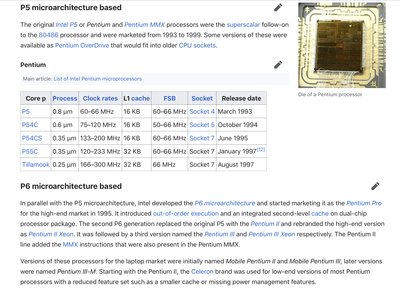Anonymous Coward wrote:JudgeMonroe wrote: DX33 seems weak for 1993 and won't push as far into the future as a DX66
Did you work in IT in 1993 or something? Only an IT person would have considered a DX-33 slow in 1993. Plus, the future-proofing argument is bunk. DX-33 and DX/2-66 are the same class of CPU with literally one speed grade in between them. The DX/2-50 was considered barely faster than a DX-33 by most magazines of the time, and the prices reflected that. The DX/2-66 was considered on average 45% faster than a DX-33. Both CPUs became obsolete at pretty much the same time, which would have been shortly after Windows 95 came out, so early 1996.
Actually, I could have sworn I had this computer in the 1980's but I guess not. I had a $2500 budget and living in Silicon Valley I always wanted to get into computers.
I use to watch "computer chronicles" allot, A local TV show about emerging computer tech.
https://youtu.be/J5_doCwi608
So a friend and I choose which components to put in my custom built PC.
A good pre-built PC was too much money and did not have all the components I want for the budget I had.
It felt like I had this computer for 10 years before I did anything meaningful with it.
I was a Novice and knew very little about DOS or MS-Windows 3.11 before.
I did take a class at school but it was very limited.
So, wanted a good computer for work and school.
What we selected was this config.
Intel 486dx-33
4mb ram
generic ISA motherboard.
128kb cache
120mb Hard drive
14.4 modem.
Sound blaster clone sound card.
Sony 2x CDROM with ISA controller
14" SVGA monitor
later I purchased a refurbished Laser printer but It was really slow to print.
it had very little ram.
I went with the 486 because of it's speed and It was a mid-level CPU at the time.
https://www.youtube.com/watch?v=BdFJZKJMerA
So computers where really taking off at the time and everyone was getting into computers.
I saw a local add in the paper for computer tutoring.
So I hired this guy to setup my computer and teach me.
We where able to get everything set up even the dial-up internet.
with access to Wild Cat BBS servers and AT&T internet service on windows 3.11
and Netscape web browser.
The computer worked fine and it seems like I had it for ten years before I really got into computers.
I also purchased some MS-Windows an MS-Office instructional VHS tapes.
Later I went to school for computers and networking.
UNIX
Sun Solaris
DOS
MS-Windows
Apple
Novell networking
HPUX
CBT's
etc.
That's when I really got into computers and I think it was 1995.
